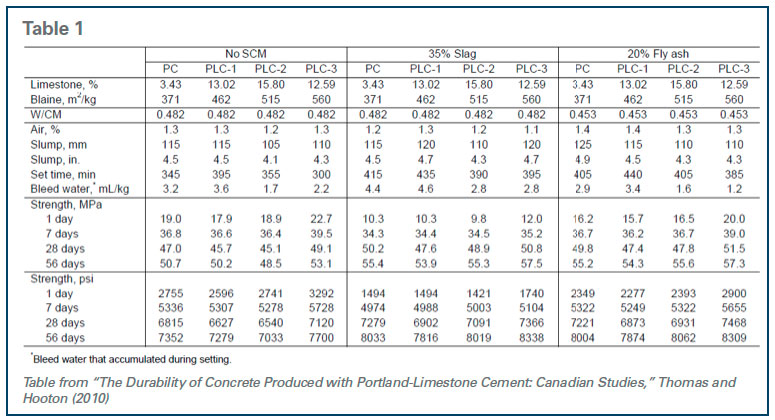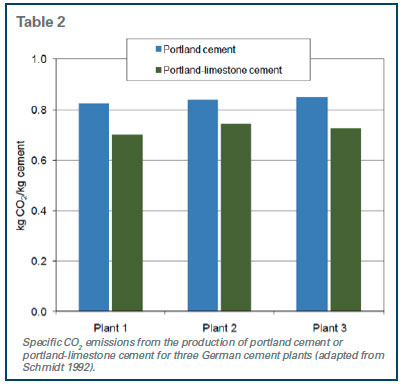When bricklayer Joseph Aspdin burned powdered limestone and clay in his kitchen stove at his home in Leeds, England, during the 1820s, he couldn’t possibly have known the impact his experiment would have on the world. It’s unlikely that he knew he was in the midst of building the foundation for a massive industry that now produces a billion tons of cement per year worldwide.
Portland cement has evolved to include many other minerals and chemicals to enhance its performance and manufacturing efficiency. However, that evolution has not eliminated the use of Aspdin’s two basic constituents: limestone and clay.
Another look at limestone
Limestone is a sedimentary rock composed mostly of the mineral calcite and aragonite, which are crystal forms of calcium carbonate (CaCO3). It can be found in many things from the Great Pyramids of Egypt to your tube of toothpaste.
Crushed limestone is often the main raw ingredient in the manufacture of portland cement clinker that eventually becomes cement. Other raw material sources of calcium carbonate include shells, chalk or marl, which are combined with shale, clay, slate, blast furnace slag, silica sand or iron ore. These raw materials are finely ground, blended in controlled proportions, and then heated in a kiln to temperatures of 2,640 F to form portland cement clinker. This clinker is ground to the fine powder known as portland cement.
In the final grinding step, other ingredients may be included, typically calcium sulfate (gypsum) and uncalcined limestone. ASTM C150 and AASHTO M85 limit the maximum limestone content to 5% by mass. ASTM C595 and AASHTO M240 were revised in 2012 to define portland-limestone cements with between 5% and 15% limestone by mass.
Portland-limestone cement (PLC) has comparable performance properties to ordinary portland cement but improves the environmental performance of concrete.
PLC has been used in the United States on a limited scale in accordance with ASTM C1157 for several years, but it is still considered a relatively new technology. Some forms of PLC have been used in Europe for more than 40 years, however. European Standard EN197-1 includes provisions for cements containing limestone in amounts up to 35%. The national Mexican standard NMX C-414 also allows up to 35% limestone. In New Zealand, PLC is produced with up to 15% limestone, and in Brazil a maximum of 10% limestone is permitted.
PLC has been used increasingly in Canada since its adoption of the CSA A3000 specification in 2008. That specification allows quantities up to 15% with similar provisions to those in ASTM C595.
Softening the standards
In the United States, as the demand for sustainable practices and materials continues to escalate, coupled with more restrictive regulations, the cement industry is working to decrease its environmental footprint. As a result, the provisions within ASTM C595 and AASHTO M240 were revised in 2012 to allow limestone contents of greater than 15% that would produce equivalent or greater performance while lowering the environmental impact.
The cements produced in the United States under ASTM C1157 for several years have a history of satisfactory performance in field applications, yet ASTM C1157 is not widely specified. That is why provisions for portland-limestone cements have been developed under ASTM C595 and AASHTO M240: a more significant impact on sustainability can be achieved as those specifications are more widely referenced.
The 2012 revisions of ASTM C595 and AASHTO M240 both have a new cement type designation: Type IL, which requires between 5% and 15% limestone as an ingredient. Most Type IL cements are around 10% to 12% limestone. Type IL cements can be substituted for ASTM C150 Type I cements, but not for Type II or Type V cements, because at this time there are no provisions for sulfate resistance. Testing is ongoing, and future revisions to ASTM will speak to this issue.
Limestone is a softer material than clinker and therefore takes less energy to grind to the same fineness. In cement finish milling, this results in better particle size distribution in the cement and enhanced particle packing and paste density in concrete. This is from a Canadian study where 12 different types of cement were separated into three groups: without supplementary cementitious materials (SCMs), with 35% slag cement and with 20% fly ash.
Within each group, ordinary portland cement was used, and then three other PLCs. The three PLC blends have different Blaine measurements, which is an indication of how finely they were ground. As you can see in Table 1, the PLC-3 in each group displayed the highest strengths and was the finer blend, with the Blaine values of 560 m2/kg.
Effects on fresh concrete
Workability. In general, the fineness of the limestone is the main factor that influences workability. Some reviews suggest that the use of limestone may alter the water demand, resulting in a slight increase or decrease compared with concrete made with conventional cements. Therefore, it appears that PLCs can be used following the same approach as conventional portland cement.
Bleeding. Particles will absorb water onto their surfaces; therefore, bleeding is highly dependent on the surface area of the cement particles. As the surface area increases, water absorption increases. Increasing the fineness of the cement or limestone will add more surface area. Water absorption will therefore increase and bleeding will decrease. The use of limestone in the cement can slightly decrease bleeding based on its fineness but generally does not have an effect.
Set Time. Based on studies, it appears that cements with limestone may have a slight effect on setting time; however, this should not constitute a concern for the addition rates of 15% or less. In general, it has been reported that the influence of limestone on setting time was strongly related to the fineness of the limestone. As the limestone was ground finer, the setting time decreased.
Hydration. Limestone particles act as nucleation sites for hydration products. This means that small limestone particles are suspended in paste between clinker grains and become intermediate sites for C-S-H (the main binding phase in concrete) growth, improving efficiency. Therefore, the inclusion of limestone can increase the rate of hydration.
During hydration of low water-to-cementitious material ratio concrete mixes, a portion of the cement often remains unhydrated. It just sits in the concrete as filler. That’s expensive filler, as cement is usually a major cost factor in concrete. Cost savings could be achieved by replacing that cement with a relatively inert material such as limestone.
Effects on hardened concrete
Strength. The quality and quantity of the limestone used plays a major part in the strength of concrete produced with PLC.
Studies have shown that limestone contents up to 15% may actually increase early-age strength as a combined result of improving particle packing, increasing the rate of cement hydration and production of calcium carboaluminate.
The reactivity of limestone has been debated. While most researchers have previously believed the limestone serves as an inert filler, research shows that limestone does react to a limited extent. As the limestone particles become finer, this reaction is more likely. Studies found that at low concentrations, limestone (calcite) reacts completely to form various carboaluminate phases.
When increasing the amount of limestone in cement to achieve higher strengths, there is a limit. Use of larger quantities of limestone (15% to 25%) can result in the dilution of the paste, and that can reduce the strengths.
Tests show that limestone cements have a special synergy with Class C fly ashes resulting in higher compressive strengths.
Permeability. Many test methods have been developed to measure the resistance of concrete to the penetration of fluids such as water, vapors or gases, and accompanying aggressive species such as chlorides or sulfates. Regardless of the test method applied, it is generally considered that the durability of concrete improves with its ability to resist the movement of fluids and ionic species.
Permeability has been shown to be reduced by the use of limestone due a reduction in the connectivity of the pores. This is due to physical mechanisms such as enhanced particle packing and paste density, and the nucleation site phenomenon discussed earlier in this article. It is also due to slight chemical reactions of the limestone. The calcium carbonate also reacts with the aluminate compounds in the cements and SCMs to produce durable carboaluminate crystals. Another side effect includes the stabilization of ettringite and increased total volume of hydration products, thus lowering porosity and increasing strength.
Interaction with SCMs and admixtures
The use of PLC can increase efficiency of SCMs such as fly ash and slag. As mentioned before, limestone cements seem to work particularly well with Class C fly ashes. Limestone in PLC may counter set retardation effects of SCMs.
Studies so far have not revealed any significant effects of PLC on the effectiveness of admixtures. Recent research seems to indicate that a slightly higher amount of air entrainment admixture was needed in mortars made with PLC relative to those with portland cements, but this may be due to the finer cements. The amounts were well within the normal range recommended by the manufacturer and did not seem to extend to concrete mixtures.
Environmental benefit
Carbon dioxide (CO2) emissions for cement plants come predominantly from two sources: calcination of the limestone, a primary raw ingredient for clinker manufacture; and fossil fuel consumption to heat the raw materials to the temperature required to form clinker.
The primary sustainability effect of using limestone as an ingredient in blended cements at levels of 5% to 15% by mass is that less clinker has to be produced for an equivalent amount of cement, and therefore less energy is consumed and CO2 emissions and other greenhouse gases are reduced. This can be seen in Table 2.
Another benefit of PLCs is their lower raw material demand, which reduces the consumption of natural resources. To produce a ton of portland cement, about 1.3 to 1.4 tons of raw materials are needed. PLCs need about 10% less primary raw materials.
Good for you, good for everyone
Precast concrete producers should always be on the lookout for any processes and materials that can reduce the cost of their products and improve sustainability while not negatively affecting performance. PLC may provide a means to that end.
The data shown in Table 1 indicate that the limestone content of cement can be increased from the level typically used in conventional portland cement (about 3.5%) to 15% while maintaining equivalent performance. This can result in reduced environmental impact and, in some cases, reduced cost.
Achieving comparable performance in concrete using PLC to that obtained using conventional portland cement is possible, because finely ground limestone can contribute to development of microstructure, particularly when fineness and chemistry of the finished cement are optimized by the manufacturer. The use of PLC should be a seamless integration in the manufacturing process of precast concrete.
If you are interested in looking into using PLC in your facility, contact your cement manufacturer to learn more. You can also find a lot of good information on the Portland Cement Association’s website at cement.org.
For more information on this subject, please feel free to contact Claude Goguen at (317) 571-9500 or at cgoguen@precast.org.
Claude Goguen, P.E., LEED AP, is NPCA’s director of Sustainability and Technical Education. Paul D. Tennis, Ph.D., who contributed to this article, is director of Product Standards and Technology, Portland Cement Association.
[separator_dots]
References
Peter Hawkins, Paul D. Tennis and Rachel Detwiler, “The Use of Limestone in Portland Cement: A State-of-the-Art Review,” Portland Cement Association, 2003
Portland-Limestone Cements: State-of-the-Art Report and Gap Analysis for CSA A3000
R.D. Hooton, M. Nokken and Michael D.A. Thomas, June 17, 2007
Michael D.A. Thomas and R. Doug Hooton, “The Durability of Concrete Produced with Portland-Limestone Cement: Canadian Studies,” SN3142, Portland Cement Association, 2010
Paul D. Tennis, Michael D.A. Thomas and Jason Weiss, “State-of-the-Art Report on Use of Limestone in Cements at Levels of up to 15%,” SN3148, Portland Cement Association, 2011

